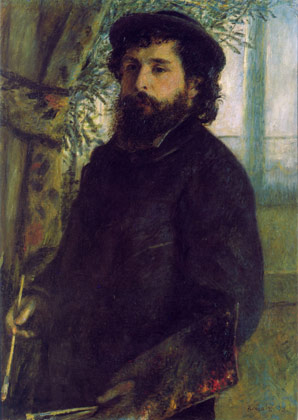The directory «Artists»
Monet Claude
(1840—1926)

Monet is recognized as being one of the creators of Impressionism, and he was the most convinced and consistent Impressionist of them all. From his earliest days as an artist, he was encouraged to trust his perceptions and the hardships he suffered never deterred him from that pursuit. Claude Monet was born in Paris on November 14, 1840 but all his impressions as a child and adolescent were linked with Le Havre, the town to which his family moved about 1845. His father had a grocery store there. In his youth he painted caricature portraits and exhibited them in the art supplies store in which Eugène Boudin worked at the time. Eventually Boudin persuaded the young Monet to paint in the open air with him and become a landscape painter. His family was not against his wish to become a painter, but his independent views, criticism towards academic art and refusal to enter a decent school of art led to constant quarrels with his family. After finishing his military service in Algeria (1860-1861) Monet attended the Académie Suisse and there made the acquaintance of Pissarro and Cézanne. Later, in 1862, he entered the Atelier Gleyre, where he met Bazille, Renoir and Sisley. In 1860s, the young artists frequented the Café Guerbois, a place often visited by Emile Zola and Edouard Manet.
An important turning point in Monet»s artistic career came in 1869, when he and Renoir painted La Grenouillere, a floating restaurant at Bougival. The canvases they produced marked the emergence of a new artistic movement, Impressionism, called so later.
In 1870, Monet married his model Camille Doncieux (died in 1879), who bore him his son Jean (1868-1914); in 1879 their second son, Michael, was born. Camille sat for many of Monet»s pictures. During the Franco-Prussian War of 1870-71 and a short civil war (Commune) that followed, Monet lived in London and was introduced to Paul Durand-Ruel, a celebrated art dealer, who did much to popularize Impressionist works. In 1874, in an atmosphere of increasing hostility on the part of official artistic circles, Monet and his friends formed a group and exhibited on their own for the first time. One of his works at this exhibition, Impression: Sunrise, gave its name to the Impessionist movement.
The following years saw a flourishing of Impressionism. Monet took part in the group»s exhibitions of 1874, 1876, 1877, 1879 and 1882. In those years he created such masterpieces as La Gare Saint-Lazare and Rue Saint-Denis, Festivities of 30 June, 1878. However, his canvases found few buyers. Desperately poor, he constantly looked for places where life was cheaper, and lived at Argenteuil from 1873 to 1878, at Vétheuil from 1879 to 1881, at Poissy in 1882, and at Giverny from 1883 until his death.
In the late 1880s, his painting began to attract the attention of both the public and critics. Fame brought comfort and even wealth. During that period the artist was absorbed in painting landscapes. Light is always the «principal person» in Monet»s landscape, and since he was always aiming at seizing an escaping effect, he adopted a habit of painting the same subject under different conditions of light, at different times of day. In this way he painted a series of views, all of the same subject, but all different in color and lightning. In 1890, Monet bought the property at Giverny and began work on the series of haystacks, which he pursued for two years. Monet painted the stacks in sunny and gray weather, in fog and covered with snow. In 1892 he married Alice Hoschedé (died in 1911) his old friend.
Monet»s renowned series of the cathedral at Rouen seen under different light effects was painted from a second-floor window above a shop opposite the façade. He made eighteen frontal views. Changing canvases with the light, Monet had followed the hours of the day from early morning with the façade in misty blue shadow, to the afternoon, when the sunset, disappearing behind the buildings of the city, weaves the weathered stone work into a strange fabric of burnt orange and blue. In 1899, Monet first turned to the subject of water lilies, the main theme of his later work. Fourteen large canvases of his Water lilies series, started in 1916, were bequeathed by him to the State. In 1927, shortly after the artist»s death, these canvases were placed in two oval rooms of the Musée de l»Orangerie in the Tuileries Gardens.
Guyana, 2001, The Quay of the Louvre